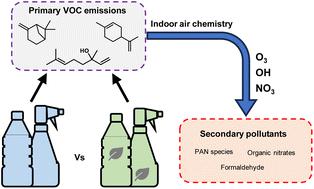当前位置:
X-MOL 学术
›
Environ. Sci.: Processes Impacts
›
论文详情
Our official English website, www.x-mol.net, welcomes your feedback! (Note: you will need to create a separate account there.)
Does green mean clean? Volatile organic emissions from regular versus green cleaning products
Environmental Science: Processes & Impacts ( IF 5.5 ) Pub Date : 2024-01-23 , DOI: 10.1039/d3em00439b Ellen Harding-Smith 1, 2 , David R. Shaw 1 , Marvin Shaw 3 , Terry J. Dillon 2 , Nicola Carslaw 1
Environmental Science: Processes & Impacts ( IF 5.5 ) Pub Date : 2024-01-23 , DOI: 10.1039/d3em00439b Ellen Harding-Smith 1, 2 , David R. Shaw 1 , Marvin Shaw 3 , Terry J. Dillon 2 , Nicola Carslaw 1
Affiliation

|
Cleaning products emit a range of volatile organic compounds (VOCs), including some which are hazardous or can undergo chemical transformations to generate harmful secondary pollutants. In recent years, “green” cleaners have become increasingly popular, with an implicit assumption that these are better for our health and/or the environment. However, there is no strong evidence to suggest that they are better for indoor air quality compared to regular products. In this study, the VOC composition of 10 regular and 13 green cleaners was examined by headspace analysis. Monoterpenes were the most prevalent VOCs, with average total monoterpene concentrations of 8.6 and 25.0 mg L−1 for regular and green cleaners, respectively. Speciated monoterpene emissions were applied to a detailed chemical model to investigate the indoor air chemistry following a typical cleaning event. Green cleaners generally emitted more monoterpenes than regular cleaners, resulting in larger increases in harmful secondary pollutant concentrations following use, such as formaldehyde (up to 7%) and PAN species (up to 6%). However, emissions of the most reactive monoterpenes (α-terpinene, terpinolene and α-phellandrene), were observed more frequently from regular cleaners, resulting in a disproportionately large impact on the concentrations of radical species and secondary pollutants that were formed after cleaning occurred.
中文翻译:

绿色意味着干净吗?普通清洁产品与绿色清洁产品的挥发性有机物排放
清洁产品会排放一系列挥发性有机化合物 (VOC),其中一些是有害的,或者会发生化学转化,产生有害的二次污染物。近年来,“绿色”清洁剂越来越受欢迎,人们隐含着这样的假设:这些清洁剂对我们的健康和/或环境更好。然而,没有强有力的证据表明它们比普通产品更能改善室内空气质量。在本研究中,通过顶空分析检测了 10 种普通清洁剂和 13 种绿色清洁剂的 VOC 成分。单萜是最常见的 VOC,普通清洁剂和绿色清洁剂的平均单萜总浓度分别为 8.6 和 25.0 mg L -1。特定的单萜排放被应用于详细的化学模型,以研究典型清洁事件后的室内空气化学。绿色清洁剂通常比普通清洁剂排放更多的单萜,导致使用后有害的二次污染物浓度大幅增加,例如甲醛(高达 7%)和 PAN 物质(高达 6%)。然而,在常规清洁剂中更频繁地观察到最具反应性的单萜(α-萜品烯、萜品油烯和α-水芹烯)的排放,这对清洁后形成的自由基物质和二次污染物的浓度产生了不成比例的巨大影响。
更新日期:2024-01-24
中文翻译:

绿色意味着干净吗?普通清洁产品与绿色清洁产品的挥发性有机物排放
清洁产品会排放一系列挥发性有机化合物 (VOC),其中一些是有害的,或者会发生化学转化,产生有害的二次污染物。近年来,“绿色”清洁剂越来越受欢迎,人们隐含着这样的假设:这些清洁剂对我们的健康和/或环境更好。然而,没有强有力的证据表明它们比普通产品更能改善室内空气质量。在本研究中,通过顶空分析检测了 10 种普通清洁剂和 13 种绿色清洁剂的 VOC 成分。单萜是最常见的 VOC,普通清洁剂和绿色清洁剂的平均单萜总浓度分别为 8.6 和 25.0 mg L -1。特定的单萜排放被应用于详细的化学模型,以研究典型清洁事件后的室内空气化学。绿色清洁剂通常比普通清洁剂排放更多的单萜,导致使用后有害的二次污染物浓度大幅增加,例如甲醛(高达 7%)和 PAN 物质(高达 6%)。然而,在常规清洁剂中更频繁地观察到最具反应性的单萜(α-萜品烯、萜品油烯和α-水芹烯)的排放,这对清洁后形成的自由基物质和二次污染物的浓度产生了不成比例的巨大影响。



























 京公网安备 11010802027423号
京公网安备 11010802027423号